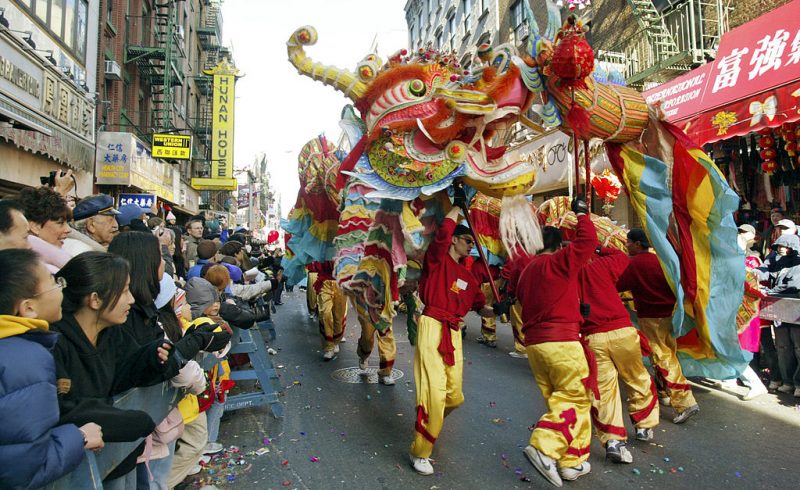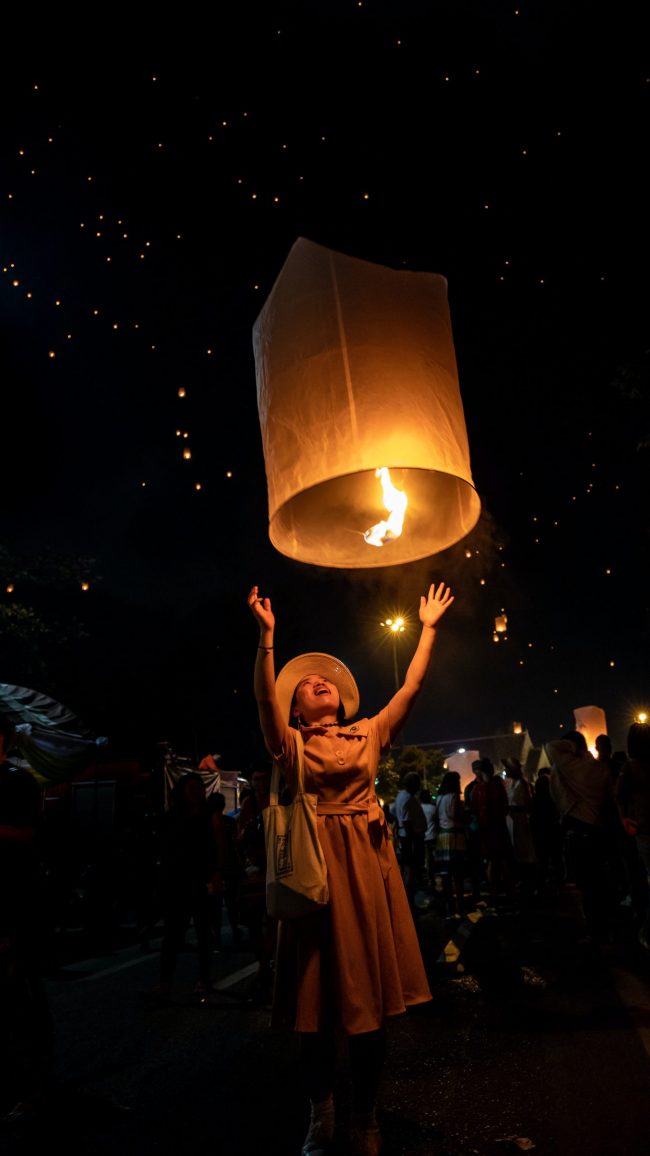
Over a billion people in China and millions around the world celebrate Lunar New Year, which in 2022 will fall on February 1. The start of the holiday coincides with the date of new moon in Asia, which will fall at 05:46 UTC on February 1, 2022. It’ll be 1:46 p.m. on February 1 in Beijing. It’ll be 12:46 a.m. on February 1 in New York City. The Lunar New Year is a time to honor deities and ancestors and to be with family. An animal represents each of the 12 years in the Chinese zodiac. In 2022, it’s the Year of the Tiger.
The Year of the Tiger will run until January 2, 2023.
The calendar and Lunar New Year
In China, the familiar Gregorian calendar is used for day-to-day life. But Chinese calendar dates continue to be used to mark traditional holidays such as the new year and the fall moon festival. Chinese astrology uses the lunar calendar for favorable dates for weddings and other special events.
The Chinese calendar is a lunisolar calendar, in other words, a combination of solar and lunar calendars. It has a long history spanning several Chinese dynastic periods from as far back as the Shang Dynasty around the 14th century BCE. There are several different symbolic cycles within the calendar, used in Chinese astrology, that make it an intricate and complex measure of time.
A month in the Chinese calendar spans a single lunar cycle. The first day of the month begins during the new moon, when no sunlight falls on the lunar hemisphere that faces Earth. A lunar cycle, on average, lasts 29.5 days, so a lunar month can last 29 or 30 days. Usually, there are 12 lunar months in a Chinese calendar year. In order to catch up with the solar calendar, which averages 365.25 days in a year, an extra month is added to the Chinese calendar every two or three years. As a result, Lunar New Year falls on different dates each year (in the Gregorian calendar) between January 21 and February 21.
The 2022 lunar calendars are here. Order yours before they’re gone!

2022 is the Year of the Tiger
One of 12 animal symbols of the Chinese zodiac (Rat, Ox, Tiger, Rabbit, Dragon, Snake, Horse, Sheep/Goat, Monkey, Rooster, Dog and Boar/Pig) represent each year of the Chinese lunar calendar. For 2022, it’s the Tiger’s turn. TravelChinaGuide.com says:
Tigers, considered to be brave, cruel, forceful and terrifying, are the symbol of power and lordliness in Chinese culture. In ancient times, people usually compared emperors or kings with the tigers. Tigers are also considered as a patron deity for children, and parents will prepare the shoes and hats with tiger designs for their babies.

How to celebrate Lunar New Year
From the first day of the Lunar New Year (the day of the new moon) to the 15th day (next full moon), Lunar New Year celebrations abound. Each day holds a special significance that varies according to local traditions. But first, before the arrival of the new year, homes are thoroughly cleaned to sweep away ill fortune and to welcome good luck. On New Year’s Eve, families traditionally gather to celebrate and enjoy sumptuous traditional feasts and to greet the new year with fireworks at midnight.
In the days that follow, celebrations include a variety of festivities. There are dance parades featuring colorful dragons or lions. There are ceremonies to pay homage to deities and ancestors. Children receive money in red envelopes and gifts are exchanged. Extended family members travel long distances to visit each other.
The Lunar New Year celebration traditionally culminates on the 15th day with the Lantern Festival. On this night of the full moon, families mingle in the streets carrying lighted lanterns, often creating a beautiful light display.

Folklore and Lunar New Year
There are several variations on the mythology behind Lunar New Year celebrations. Most concern the story of an ugly, bloodthirsty monster named Nian that would emerge on the last night of each year to destroy villages and eat people. A wise elder advised villagers to scare the monster away with loud noises. That night, they set fire to bamboo, lit fireworks, and banged their drums. The monster, afraid of the loud noises and lights, ran away to hide in its cave.
In another version of the myth, an old man persuaded Nian to turn its wrath on other monsters, not the villagers. Before he was seen riding away on Nian, the old man, actually a god, advised the people to hang red paper decorations in their homes and set off firecrackers on the last night of the year to keep Nian away.
On the first day of the new year, the villagers celebrated, greeting each other with the words Guo Nian, which mean “survive the Nian.” That tradition has continued to this day, with Guo Nian now meaning “celebrate the new year.”
The world’s biggest New Year celebration
Historically, the Lunar New Year signals the arrival of the world’s largest annual human migration. However, due to the pandemic and its subsequent variants, the mass travel event has temporarily halted. The Chinese government discourages travel during the pandemic.
Bottom line: The Lunar New Year corresponds with the new moon, which falls on February 1, 2022. This year is the Year of the Tiger.
Read Lunar New Year recipes: 5 Asian cooks share dishes from their celebrations
The post Lunar New Year 2022 heralds the Year of the Tiger first appeared on EarthSky.
from EarthSky https://ift.tt/3H9mNTf

Over a billion people in China and millions around the world celebrate Lunar New Year, which in 2022 will fall on February 1. The start of the holiday coincides with the date of new moon in Asia, which will fall at 05:46 UTC on February 1, 2022. It’ll be 1:46 p.m. on February 1 in Beijing. It’ll be 12:46 a.m. on February 1 in New York City. The Lunar New Year is a time to honor deities and ancestors and to be with family. An animal represents each of the 12 years in the Chinese zodiac. In 2022, it’s the Year of the Tiger.
The Year of the Tiger will run until January 2, 2023.
The calendar and Lunar New Year
In China, the familiar Gregorian calendar is used for day-to-day life. But Chinese calendar dates continue to be used to mark traditional holidays such as the new year and the fall moon festival. Chinese astrology uses the lunar calendar for favorable dates for weddings and other special events.
The Chinese calendar is a lunisolar calendar, in other words, a combination of solar and lunar calendars. It has a long history spanning several Chinese dynastic periods from as far back as the Shang Dynasty around the 14th century BCE. There are several different symbolic cycles within the calendar, used in Chinese astrology, that make it an intricate and complex measure of time.
A month in the Chinese calendar spans a single lunar cycle. The first day of the month begins during the new moon, when no sunlight falls on the lunar hemisphere that faces Earth. A lunar cycle, on average, lasts 29.5 days, so a lunar month can last 29 or 30 days. Usually, there are 12 lunar months in a Chinese calendar year. In order to catch up with the solar calendar, which averages 365.25 days in a year, an extra month is added to the Chinese calendar every two or three years. As a result, Lunar New Year falls on different dates each year (in the Gregorian calendar) between January 21 and February 21.
The 2022 lunar calendars are here. Order yours before they’re gone!

2022 is the Year of the Tiger
One of 12 animal symbols of the Chinese zodiac (Rat, Ox, Tiger, Rabbit, Dragon, Snake, Horse, Sheep/Goat, Monkey, Rooster, Dog and Boar/Pig) represent each year of the Chinese lunar calendar. For 2022, it’s the Tiger’s turn. TravelChinaGuide.com says:
Tigers, considered to be brave, cruel, forceful and terrifying, are the symbol of power and lordliness in Chinese culture. In ancient times, people usually compared emperors or kings with the tigers. Tigers are also considered as a patron deity for children, and parents will prepare the shoes and hats with tiger designs for their babies.

How to celebrate Lunar New Year
From the first day of the Lunar New Year (the day of the new moon) to the 15th day (next full moon), Lunar New Year celebrations abound. Each day holds a special significance that varies according to local traditions. But first, before the arrival of the new year, homes are thoroughly cleaned to sweep away ill fortune and to welcome good luck. On New Year’s Eve, families traditionally gather to celebrate and enjoy sumptuous traditional feasts and to greet the new year with fireworks at midnight.
In the days that follow, celebrations include a variety of festivities. There are dance parades featuring colorful dragons or lions. There are ceremonies to pay homage to deities and ancestors. Children receive money in red envelopes and gifts are exchanged. Extended family members travel long distances to visit each other.
The Lunar New Year celebration traditionally culminates on the 15th day with the Lantern Festival. On this night of the full moon, families mingle in the streets carrying lighted lanterns, often creating a beautiful light display.

Folklore and Lunar New Year
There are several variations on the mythology behind Lunar New Year celebrations. Most concern the story of an ugly, bloodthirsty monster named Nian that would emerge on the last night of each year to destroy villages and eat people. A wise elder advised villagers to scare the monster away with loud noises. That night, they set fire to bamboo, lit fireworks, and banged their drums. The monster, afraid of the loud noises and lights, ran away to hide in its cave.
In another version of the myth, an old man persuaded Nian to turn its wrath on other monsters, not the villagers. Before he was seen riding away on Nian, the old man, actually a god, advised the people to hang red paper decorations in their homes and set off firecrackers on the last night of the year to keep Nian away.
On the first day of the new year, the villagers celebrated, greeting each other with the words Guo Nian, which mean “survive the Nian.” That tradition has continued to this day, with Guo Nian now meaning “celebrate the new year.”
The world’s biggest New Year celebration
Historically, the Lunar New Year signals the arrival of the world’s largest annual human migration. However, due to the pandemic and its subsequent variants, the mass travel event has temporarily halted. The Chinese government discourages travel during the pandemic.
Bottom line: The Lunar New Year corresponds with the new moon, which falls on February 1, 2022. This year is the Year of the Tiger.
Read Lunar New Year recipes: 5 Asian cooks share dishes from their celebrations
The post Lunar New Year 2022 heralds the Year of the Tiger first appeared on EarthSky.
from EarthSky https://ift.tt/3H9mNTf

Aucun commentaire:
Enregistrer un commentaire